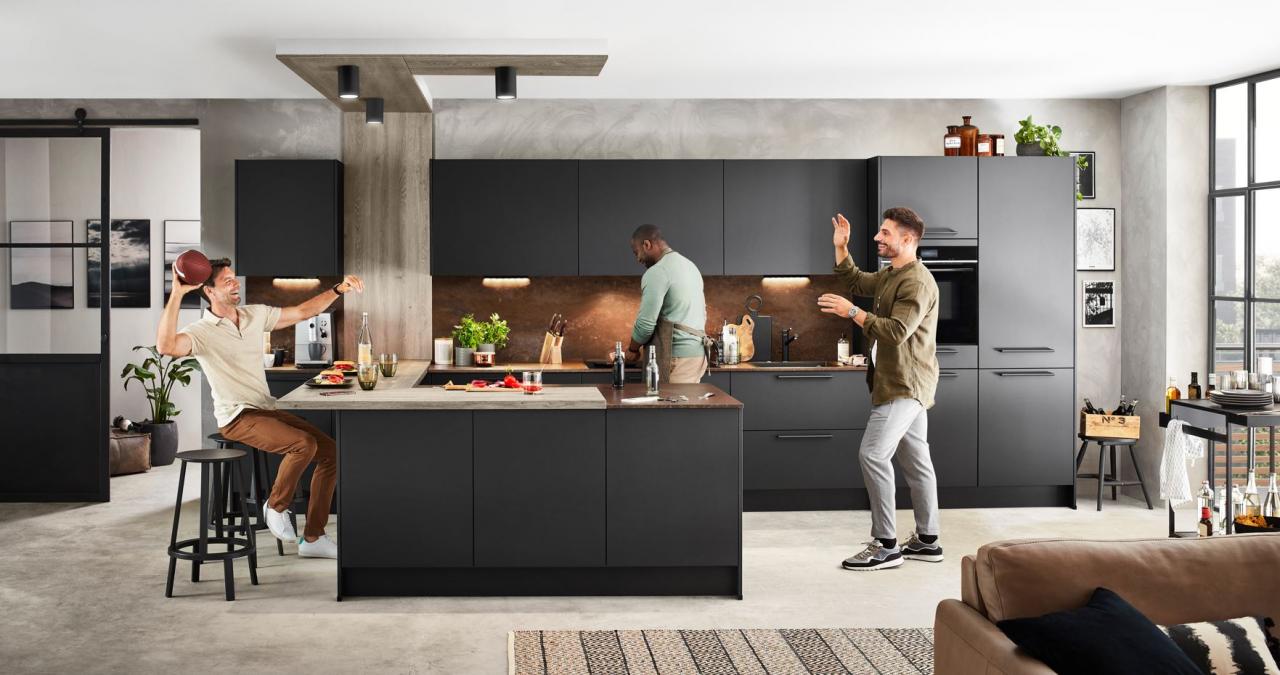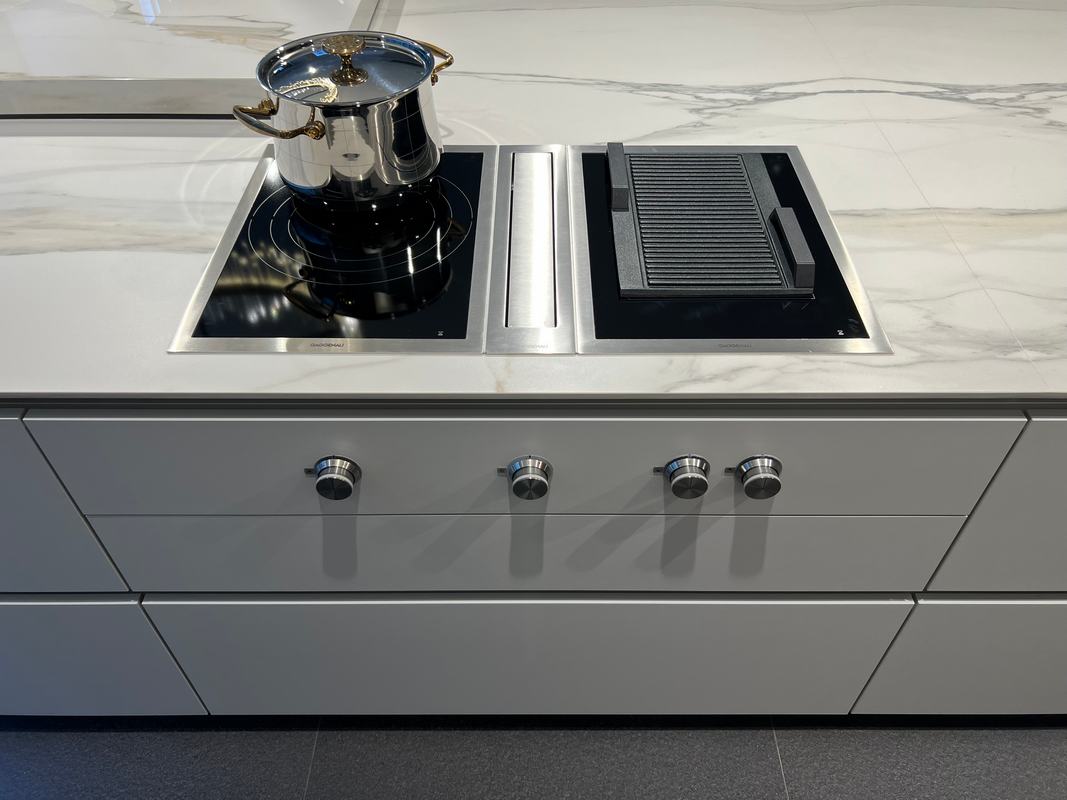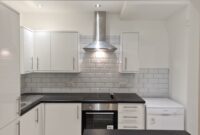Tips for buying a used kitchen in Germany: Navigating the German used kitchen market can seem daunting, but with the right approach, you can find a great deal on a quality kitchen. This guide breaks down the process, from finding listings online to negotiating the price and arranging transport. We’ll cover essential inspections, legal considerations, and everything in between, helping you confidently secure your dream kitchen without breaking the bank.
Finding the perfect used kitchen involves careful planning and research. Understanding the various online marketplaces, effectively assessing the condition of the kitchen, and negotiating a fair price are crucial steps. This guide will equip you with the knowledge and strategies to make informed decisions and avoid potential pitfalls. We’ll also address the logistical aspects of transportation and installation, ensuring a smooth transition from purchase to enjoying your new (to you!) kitchen.
Finding Used Kitchens in Germany
Finding a pre-owned kitchen in Germany can be a great way to save money and find a unique style. Several online platforms cater specifically to this market, offering a wide selection of kitchens from various sellers. Navigating these platforms effectively requires understanding their search functionalities and the typical information provided in listings.
Common Online Marketplaces and Classifieds Websites
Several popular websites in Germany specialize in connecting buyers and sellers of used goods, including kitchens. eBay Kleinanzeigen is arguably the most well-known, acting as a vast classifieds platform where individuals and businesses list a wide range of items, including used kitchens. Other significant players include markt.de and Quoka.de, which offer similar functionalities with slightly different user interfaces and search options.
These platforms typically allow for detailed searches using s, location filters, and price ranges.
Searching for Specific Kitchen Features
Each platform offers its own search filters. Generally, you can refine your search by specifying materials (e.g., “Echtholz” for real wood, “Hochglanz” for high-gloss), style (e.g., “modern,” “landhaus,” “shabby chic”), and dimensions (e.g., “200cm,” “L-förmig” for L-shaped). Many allow searches by appliance brands if you’re looking for specific integrated ovens, dishwashers, or refrigerators. Using a combination of s and filters increases the likelihood of finding kitchens matching your preferences.
For example, searching for “Eiche Küche 280cm” on eBay Kleinanzeigen would likely yield results for oak kitchens around 280cm in length.
Typical Information Included in Used Kitchen Listings
Used kitchen listings typically include crucial information for potential buyers. This usually encompasses dimensions (length, width, depth of individual units), age of the kitchen (year of manufacture or installation), a description of its condition (including any damage or wear and tear), and the asking price. High-quality listings often include multiple photos showing the kitchen from various angles, detailed close-ups of the cabinetry, and even images of the included appliances.
Some sellers may also provide information about the materials used in the construction, the type of countertops, and the included appliances.
Comparison of German Websites for Buying Used Kitchens
| Website | Features | Ease of Use | Pros | Cons |
|---|---|---|---|---|
| eBay Kleinanzeigen | Vast selection, detailed search filters, direct communication with sellers. | Generally user-friendly, but can be overwhelming due to the sheer volume of listings. | Huge inventory, diverse options. | Requires careful filtering to find relevant results. |
| markt.de | Good selection, intuitive search, professional listings (some sellers). | Easy to navigate, well-organized categories. | Cleaner interface than eBay Kleinanzeigen. | Potentially smaller inventory than eBay Kleinanzeigen. |
| Quoka.de | Similar features to markt.de, regional focus. | User-friendly, strong regional search capabilities. | Focus on local listings. | Might have a smaller selection depending on location. |
Assessing the Condition of a Used Kitchen: Tips For Buying A Used Kitchen In Germany
Buying a used kitchen in Germany can offer significant savings, but a thorough inspection is crucial to avoid costly surprises. This section details how to assess the condition of a used kitchen, focusing on cabinets, countertops, appliances, and potential structural issues. A careful evaluation will help you make an informed decision and ensure a smooth transition into your new kitchen.
Cabinet Inspection
A detailed examination of the cabinets is paramount. Pay close attention to both the exterior and interior. Look for signs of damage, such as scratches, dents, or swelling from water damage. Check the hinges, handles, and drawer slides for smooth operation. Loose or damaged hardware indicates potential problems and may require replacement, adding to your overall cost.
Inspect the cabinet doors and drawers for alignment; misalignment suggests warping or damage to the cabinet structure. Finally, check the interior of the cabinets for any signs of mold or mildew, indicating potential water damage.
Countertop Assessment
Countertops are subject to daily wear and tear. Examine the surface for chips, cracks, stains, and burns. Consider the material; laminate is more susceptible to damage than granite or solid surface materials. Look for any signs of unevenness or warping, which could indicate structural problems beneath the countertop. For stone countertops, check for any signs of cracking or discoloration.
Also check the edges and seams for chipping or separation.
Appliance Evaluation, Tips for buying a used kitchen in Germany
Testing appliances is essential before purchase. If possible, test each appliance to ensure it’s functioning correctly. Check the oven for proper heating, the refrigerator for cooling, and the dishwasher for cleaning. Note any unusual noises, smells, or leaks. Inspect the exterior for dents, scratches, or rust.
Check the manuals and serial numbers to determine age and warranty status, if any. Consider the energy efficiency rating of the appliances, as this can impact your long-term costs.
Identifying Potential Structural Problems and Water Damage
Signs of water damage can be subtle but significant. Look for discoloration, swelling, or warping of the cabinets or flooring. Check for signs of mold or mildew, especially in corners or under sinks. Inspect the walls and ceiling around the kitchen for any water stains. Pay close attention to areas near plumbing fixtures, such as the sink and dishwasher, as these are common sources of leaks.
A damp or musty smell can also indicate hidden water damage. Consider hiring a professional to assess the kitchen for structural issues if you are unsure.
Visual Guide to Common Kitchen Defects
Imagine a visual guide with four panels, each showcasing a different type of kitchen defect.Panel 1: Minor Chip in Laminate Countertop: A small, superficial chip on a laminate countertop is shown. The image clearly shows the damage is localized and doesn’t compromise the structural integrity of the countertop. The severity is labeled as “Low”.Panel 2: Swollen Cabinet Door: A cabinet door visibly swollen at the bottom edge is displayed.
The swelling indicates water damage and potential underlying structural issues. The severity is labeled as “Medium”.Panel 3: Cracked Ceramic Sink: A significant crack running across a ceramic sink is shown. This is a major defect requiring repair or replacement. The severity is labeled as “High”.Panel 4: Extensive Mold Growth: A close-up image reveals extensive mold growth inside a cabinet. This indicates significant water damage and a potential health hazard.
The severity is labeled as “Critical”.
Negotiating the Price and Purchase
Buying a used kitchen in Germany often involves negotiation, so be prepared to haggle respectfully. The seller’s initial price might be higher than what you’re willing to pay, leaving room for a mutually beneficial agreement. Remember, politeness and a clear understanding of the kitchen’s value are key to a successful negotiation.
Negotiation Strategies
Effective negotiation involves a balance of firmness and flexibility. Research comparable used kitchens in your area to establish a fair market value. This will give you a strong basis for your counter-offers. Don’t be afraid to point out any flaws or imperfections that might warrant a price reduction. A polite but assertive approach, focusing on the kitchen’s condition and your budget, will generally yield the best results.
For example, if the seller lists a kitchen for €2,000 but you’ve found similar ones selling for €1,500, you might start your negotiation at €1,600, justifying your offer with your research. Be prepared to walk away if the seller is unwilling to compromise on a reasonable price.
Payment Methods
Several payment methods are common when purchasing a used kitchen in Germany. Cash remains a popular choice for smaller transactions, offering immediate payment and a simple process. Bank transfers are also widely used, providing a secure and traceable record of the transaction. Payment services like PayPal are becoming increasingly common, offering buyer protection and convenience. Financing options, while less common for used kitchens, might be available depending on the seller and the kitchen’s value.
Choosing the right method depends on the amount, your comfort level, and the seller’s preferences. For larger sums, a bank transfer is generally preferred for security reasons.
Importance of a Written Contract
A comprehensive written contract is crucial for protecting both the buyer and the seller. This legally binding document should clearly Artikel all aspects of the sale, including the agreed-upon price, payment terms, delivery date, and any warranties or guarantees. Specify the condition of the kitchen, noting any existing damages or defects. Including details about the dismantling, transportation, and reassembly of the kitchen is also essential, particularly if the seller is responsible for any of these aspects.
Without a written contract, disputes can arise easily, making the process much more complicated.
Paperwork and Legal Aspects
Buying a used kitchen involves several steps. First, agree on the price and payment method. Then, create a detailed written contract, including the seller’s and buyer’s personal information, a precise description of the kitchen (including any defects), the agreed price, payment terms, and a delivery schedule. If the seller offers a warranty, this must be explicitly stated in the contract.
Finally, both parties sign and retain copies of the contract. For significant purchases, seeking legal advice is advisable to ensure the contract comprehensively protects your interests. Keep all receipts and documentation related to the transaction. This meticulous record-keeping provides protection should any issues arise later. Consider using a simple, pre-printed contract form readily available online, modifying it to reflect the specifics of your purchase.
Transportation and Installation

Source: webflow.com
Getting your used kitchen from point A to point B and then setting it up in your new home is a crucial step. This process can be surprisingly complex, involving careful planning, efficient execution, and potentially significant costs. Let’s explore the options and strategies to ensure a smooth transition.
Transportation Options
Choosing the right transportation method depends on factors like the size of the kitchen, the distance, your budget, and your DIY skills. Several options exist, each with its own set of advantages and disadvantages.
- Self-Transport: This option is the most cost-effective if you own a suitable vehicle (van or truck with sufficient space) and have the necessary manpower to load, transport, and unload the kitchen components. However, it demands considerable time, effort, and careful planning to avoid damage during transport.
- Professional Movers: Hiring professional movers specializing in furniture or kitchen relocation offers convenience and peace of mind. They possess the expertise, equipment (e.g., specialized trucks and dollies), and insurance to handle the transportation safely and efficiently. This option is generally more expensive but significantly reduces the risk of damage and stress.
- Specialized Dismantling and Transportation Services: Some companies specialize in dismantling, transporting, and reassembling used kitchens. This comprehensive service alleviates the burden of handling the disassembly and reassembly yourself, minimizing the risk of damage and ensuring a professional installation. Expect this to be the most expensive option.
Cost Comparison of Transportation Methods
The cost of transportation varies significantly depending on the factors mentioned above. As a rough estimate, self-transport might cost only the fuel and potential vehicle rental fees (e.g., €50-€150). Professional movers could charge anywhere from €300 to €1000 or more, depending on the distance, volume, and complexity of the move. Specialized dismantling and transportation services are typically the most expensive, potentially costing €1000-€2500 or more for a larger kitchen.
These are just estimations, and obtaining quotes from several providers is crucial for accurate pricing.
Safe Dismantling and Reassembly
Proper dismantling and reassembly are essential to prevent damage and ensure the kitchen’s functionality. Thorough planning and careful execution are vital.
- Detailed Documentation: Before dismantling, take detailed photos and videos of each step, noting the position and connections of all components. This will be invaluable during reassembly.
- Careful Labeling: Label all parts clearly with their corresponding locations. Use a system that is easy to understand during reassembly. Numbering parts can be helpful.
- Protective Packaging: Use appropriate padding and wrapping materials (e.g., bubble wrap, cardboard) to protect components during transport. Consider using furniture blankets to prevent scratches.
- Professional Assistance: If you lack experience, consider seeking professional help for dismantling and reassembly to minimize the risk of damage and ensure a proper installation.
Transport and Installation Flowchart
The flowchart below visually represents the steps involved in transporting and installing a used kitchen. Note that this is a general Artikel and specific steps may vary depending on the circumstances.[Imagine a flowchart here: The flowchart would begin with “Find Used Kitchen,” branching to “Arrange Transportation (Self/Professional/Specialized),” then to “Dismantle Kitchen (if necessary),” then to “Transport Kitchen,” then to “Prepare New Location,” then to “Reassemble Kitchen,” and finally to “Final Inspection.”]
Legal and Financial Considerations

Source: usedkitchenhub.com
Buying a used kitchen in Germany involves several legal and financial aspects that buyers should be aware of to protect themselves. Understanding these considerations can help ensure a smooth and legally sound transaction. This section Artikels key legal requirements, potential tax implications, and inherent risks, providing a framework for informed decision-making.
German Legal Requirements for Selling and Buying Used Goods
German law generally treats the sale of used goods like any other contract. The sale is governed by the Bürgerliches Gesetzbuch (BGB), the German Civil Code. This means the seller is obligated to provide a product that corresponds to the agreement made with the buyer. This includes ensuring the kitchen is free from significant defects not explicitly disclosed beforehand.
The seller is liable for defects that existed at the time of the sale, even if they were not immediately apparent. The buyer has the right to demand repair, replacement, or price reduction if significant defects are discovered within a reasonable timeframe (usually six months, but this can vary depending on the circumstances). Thorough inspection and detailed documentation of the condition of the kitchen are crucial to avoid disputes later.
A written contract specifying the condition of the kitchen, agreed-upon price, and payment terms is strongly recommended.
Tax Implications of Purchasing a Used Kitchen
Generally, the purchase of a used kitchen is not subject to Value Added Tax (Mehrwertsteuer or MwSt). However, if the seller is a business and is selling the kitchen as part of their business operations, MwSt might apply. In such cases, the seller is obligated to charge and account for MwSt. The buyer should clarify this with the seller upfront and request documentation confirming the VAT status of the transaction, if applicable.
Private sellers generally do not charge MwSt.
Potential Risks and Liabilities in Buying a Used Kitchen
Buying a used kitchen inherently carries certain risks. These include the possibility of hidden defects, such as faulty wiring, plumbing issues, or damaged components that are not immediately visible during inspection. There’s also the risk of the kitchen not fitting the buyer’s space perfectly, requiring costly adjustments or modifications. Furthermore, the seller might not possess all the necessary documentation, such as proof of ownership or compliance with safety regulations.
It’s vital to conduct a thorough inspection, potentially with a qualified professional, to mitigate these risks.
Questions to Ask the Seller Before Purchase
Before committing to a purchase, it’s crucial to ask the seller several clarifying questions. This ensures a transparent and informed transaction. The following questions are essential:
- What is the age and origin of the kitchen?
- Are there any known defects or issues with the kitchen?
- Does the seller have all the necessary documentation, including proof of ownership?
- What is included in the sale (appliances, countertops, sink, etc.)?
- What is the reason for selling the kitchen?
- What are the payment terms and methods accepted?
- Can a professional inspection of the kitchen be arranged?
- Is there a warranty or guarantee offered on the kitchen?
Last Recap
Buying a used kitchen in Germany offers a fantastic opportunity to save money and find a unique kitchen that suits your style. By following the tips and advice Artikeld in this guide, you can navigate the process with confidence. Remember to thoroughly inspect the kitchen, negotiate effectively, and understand the legal and financial aspects involved. With careful planning and attention to detail, you’ll be enjoying your beautiful, budget-friendly, used kitchen in no time!
Answers to Common Questions
What’s the average lifespan of a German kitchen?
A well-maintained German kitchen can last 15-20 years or even longer.
How do I handle potential warranty issues with a used kitchen?
Always negotiate a written agreement with the seller outlining any warranties or guarantees, even if limited. Specify what’s covered and the duration.
Are there any specific permits needed for kitchen installation?
Depending on the extent of the renovation, you might need building permits. Check with your local Bauamt (building authority).
What are some common scams to watch out for?
Be wary of unusually low prices and sellers who are unwilling to provide detailed information or allow thorough inspections. Always meet in person and pay securely.
Can I finance the purchase of a used kitchen?
While less common than for new kitchens, some private lenders or banks might offer financing options. Check with your bank.



